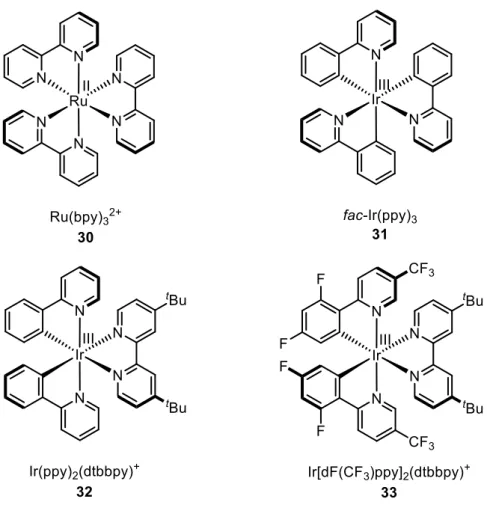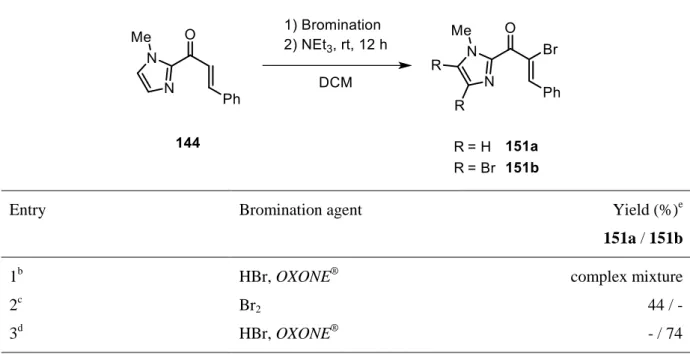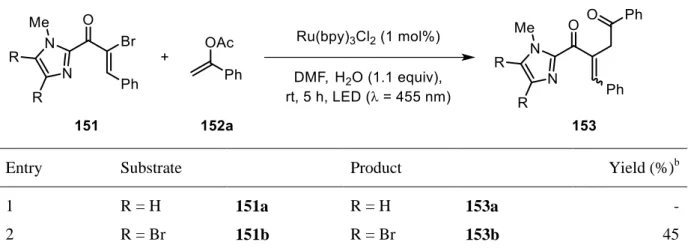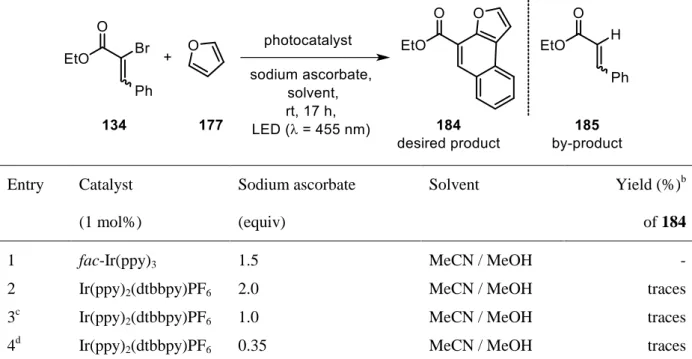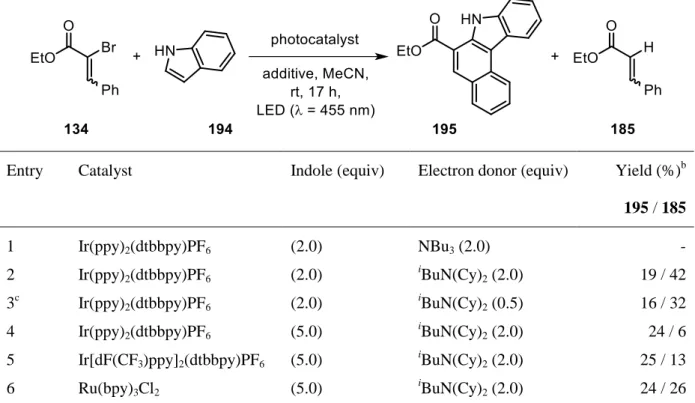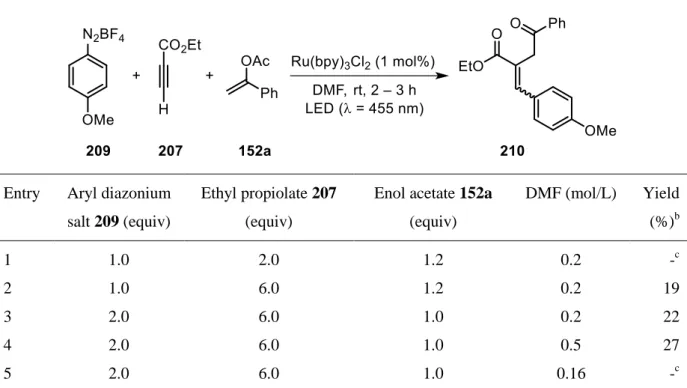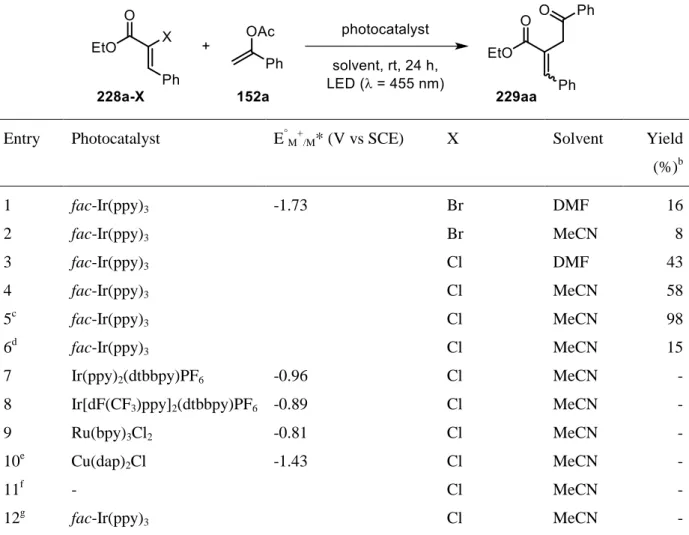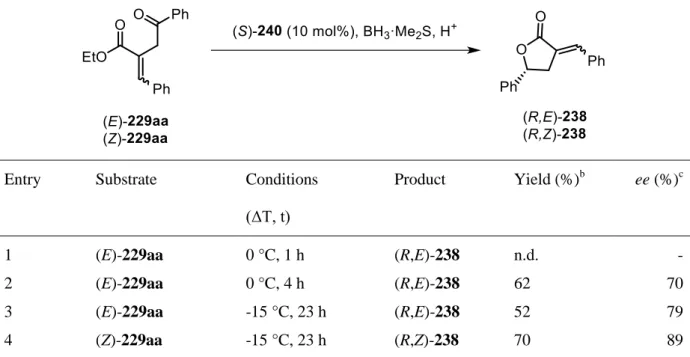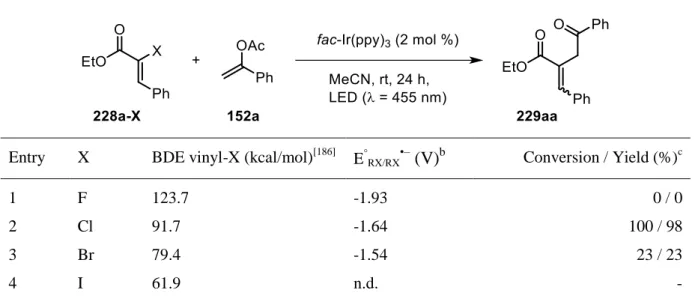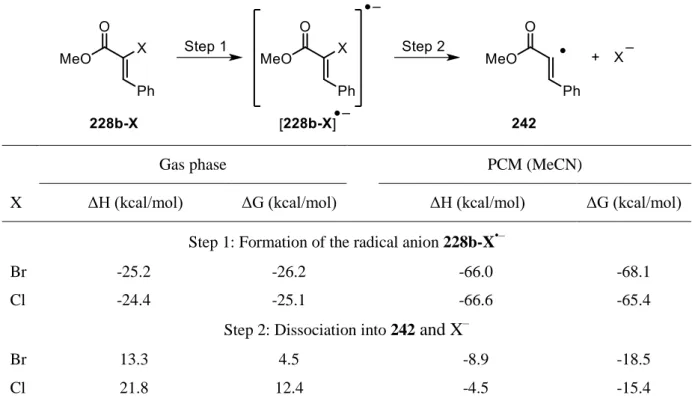halides
Dissertation
Zur Erlangung des Doktorgrades der Naturwissenschaften Dr. rer. nat.
der Fakultät für Chemie und Pharmazie der Universität Regensburg
vorgelegt von Thomas Föll aus Niederaichbach
Regensburg 2019
Diese Arbeit wurde angeleitet von: Prof. Dr. Oliver Reiser Promotionsgesuch eingereicht am: 30.01.2019
Promotionskolloquium am: 27.02.2019
Prüfungsausschuss: Vorsitz: Prof. Dr. Hubert Motschmann 1. Gutachter: Prof. Dr. Oliver Reiser
2. Gutachter: Prof. Dr. Julia Rehbein
3. Gutachter: Prof. Dr. Robert Wolf
Chemie der Universität Regensburg angefertigt.
Herrn Prof. Dr. Oliver Reiser möchte ich herzlich für die Aufnahme in seinen Arbeitskreis,
die Themenstellung, sowie für die anregenden Diskussionen und seine stete Unterstützung
während der Durchführung dieser Arbeit danken.
Meiner Familie
„Real success is finding your lifework in the work that you love”
-David McCullough
A Introduction ... 1
1 Generation and reactivity of vinyl radicals ... 1
2 Photophysical background of photocatalysts ... 8
3 Reactions of vinyl radicals promoted by visible light ... 11
B Visible light mediated activation of vinyl halides... 30
1 Introduction ... 30
2 Preliminary studies with vinyl bromides ... 32
2.1 Cleavable redox auxiliary as activating group ... 32
2.2 Controlling the reduction potential ... 39
2.3 Utilizing the reductive quenching cycle ... 44
2.4 Formation of the vinyl radical in situ by a multicomponent cascade process ... 50
2.5 Conclusion ... 57
3 Visible light mediated activation of α-chloro cinnamates ... 58
3.1 Literature background ... 58
3.2 Optimization of the reaction conditions ... 61
3.3 Substrate scope ... 64
3.4 Up-scaling of the photochemical transformation and enantioselective synthesis of α-alkylidene-γ-aryl-γ-butyrolactone (238) ... 70
3.5 Unraveling the halogen paradox - Mechanistic discussions, computational details and control experiments ... 76
3.6 Conclusion ... 84
4 Visible light mediated activation of α-chloro cinnamonitriles ... 85
4.1 Optimization of the reaction conditions ... 85
4.2 Substrate scope ... 88
4.3 Proposed reaction mechanism ... 92
4.4 Conclusion and outlook ... 93
C Summary ... 94
D Zusammenfassung ... 97
E Experimental part ... 100
1 General information ... 100
2 Preliminary studies with vinyl bromides ... 101
3 Synthesis of α-halo cinnamates (228a – 228u) ... 109
4 Synthesis of enol acetates (152a – 152m) ... 123
5 Photochemical functionalization of α-chloro cinnamates (229aa – 229ra) ... 130
6 Photochemical reaction setup for big scale synthesis of 229aa ... 153
9 Photochemical functionalization of α-chloro cinnamonitriles (249aa – 249ga) ... 161
F References ... 175
G Appendix ... 183
1 Reduction potentials of α-halo cinnamates ... 183
2 NMR spectra of new compounds ... 184
3 Chiral HPLC chromatograms ... 298
4 X-ray crystallography data ... 300
5 Curriculum Vitae ... 307
H Acknowledgement ... 309
I Declaration ... 311
Å angstrom
A ampere
abs absolute
Ac acetyl
AcOH acetic acid
AIBN azobisisobutyronitrile anhyd anhydrous
aq aqueous
Ar aryl
atm atmosphere
ATRA atom transfer radical addition
BDE bond dissociation energy Bn benzyl (PhCH
2)
Boc tert-butoxycarbonyl
bpy 2,2’-bipyridine, 2,2’-bipyridyl br broad (spectral peak)
Bu butyl
BuLi butyl lithium Bz benzoyl (PhCO)
°C degrees Celsius
C catalyst
CBS Corey-Bakshi-Shibata
13
C-NMR carbon NMR Cbz carboxybenzyl
CFL compact fluorescent lamp cf. confer
CI chemical ionization cm centimeter
cm
-1wavenumbers conv conversion CT charge transfer CV cyclic voltammetry Cy cyclohexyl
δ chemical shift (ppm) downfield from TMS
ΔT heat
d days; doublet (spectral) dap 2,9-bis(p-anisyl)-1,10-
phenanthroline
DCC N,N’-dicyclohexylcarbodiimide DCE 1,2-dichloroethane
DCM dichloromethane decomp. decomposition
dF(CF
3)ppy 2-(2,4-difluorophenyl)-5- (trifluoromethyl)pyridine DIPEA N,N-diisopropylethylamine DMDC dimethyl dicarbonate DMN 1,5-dimethoxynaphthalene DMAP 4-(N,N-dimethylamino)pyridine DME 1,2-dimethoxyethane
DMF N,N-dimethylformamide DMSO dimethylsulfoxide dr diastereomeric ratio
dtbbpy 4,4’-ditertbutyl-2,2’-bipyridine
E
°1/2standard reduction potential ed. edition
Ed. editor(s)
EDG electron donating group ee enantiomeric excess e.g. exempli gratia, for example equiv equivalent(s)
ESI electrospray ionization
Et ethyl
et al. and others (co-authors) EWG electron withdrawing group
F Faraday
FPW Freeze-Pump-Thaw
g gram(s); gaseous
h hour(s)
HAT hydrogen atom transfer
1
H-NMR proton NMR
HOMO highest occupied molecular orbital HPLC high-performance liquid
chromatography
HRMS high-resolution mass spectrometry HSAB hard soft acid base
hν light
Hz Hertz
i
Bu iso-butyl i.e. that is
IET intramolecular electron transfer IR infrared
ISC intersystem crossing
J coupling constant (in NMR analysis)
k kilo
K Kelvin
kcal kilocalorie
L liter; ligand
LAH lithium aluminum hydride LDA lithium diisopropylamide LED light emitting diode λ
maxmax UV-vis wavelength
LUMO lowest unoccupied molecular orbital
µ micro
m meter; milli; multiplet (spectral) M molar (moles per liter)
M
+parent molecular ion (in MS)
max maximum
MCR multicomponent reaction
Me methyl
MeCN acetonitrile MHz megahertz
min minute(s); minimum mL milliliter
MLCT metal to ligand charge transfer mm millimeter
mM millimolar
mmHg millimeter of mercury mmol millimole(s)
mol mole(s)
MS mass spectrometry; molecular sieves Ms mesyl (methanesulfonyl)
m/z mass to charge ratio (in MS)
NBS N-bromosuccinimide
nm nanometer
NMR nuclear magnetic resonance ns nanosecond(s)
Nu nucleophile
OXONE
®potassium peroxymonosulfate
PCET proton-coupled electron transfer PCM polarizable continuum model PET photoinduced electron transfer pH proton log units
Ph phenyl
PMB 4-methoxybenzyl ether ppm part(s) per million ppy 2-phenylpyridine
i
Pr iso-propyl
PTSA p-toluenesulfonic acid
q quartet (spectral) quin quintet (spectral)
R arbitrary moiety rac. racemic
red reduction
redox reduction-oxidation
R
fretention factor (in chromatography) rt room temperature
s seconds; singlet (spectral) sat. saturated
SCE saturated calomel electrode sept septet (spectral)
SET single electron transfer sext sextet (spectral)
t triplet (spectral) T temperature
TBAB tetra-n-butylammonium bromide TBHP tert-butyl hydroperoxide
TBS tert-butyldimethylsilyl ether
t
Bu tert-butyl
TEMPO 2,2,6,6-tetramethylpiperidine 1-oxyl TES Triethylsilyl ether
Tf trifluoromethanesulfonyl (triflyl) TFA trifluoroacetic acid
TFAA trifluoroacetic anhydride Tfoc 2,2,2-trifluoroethoxy carbonyl THF tetrahydrofuran
TLC thin-layer chromatography TMS trimethylsilyl, tetramethylsilane,
thermomorphic solvent system t
Rretention time (in chromatography) Ts p-toluenesulfonyl (tosyl)
TS transition state
UV ultraviolet (light)
vis visible
vol volume
vs versus
X arbitrary reagent 1; halogen
Y arbitrary reagent 2
1
A Introduction
1 Generation and reactivity of vinyl radicals
It has been slightly more than 100 years since the pioneering work of Gomberg who discovered the first organic free radical upon treatment of triphenylmethyl chloride with elemental zinc.
[1]A century later, free radicals have become an integral part of modern organic chemistry and are nowadays widely employed. In this regard, remarkable advances have been achieved in the field of different reaction types including chain reactions, defunctionalization chemistry, complex intramolecular cyclizations, radical translocations, or exceptional rearrangements.
[2-7]With the discovery of trialkyltin hydrides as radical precursors in the 1960s,
[8,9]numerous applications and different kinds of radicals were reported. However, these transformations were predominantly based on alkyl radicals and comparatively less attention was dedicated to vinyl radicals.
[10-12]Being considered too reactive and uncontrollable, only a handful reports described vinyl radicals as intermediates. It took until the 1980s when pioneering work by Curran and Stork turned their attention towards vinyl radicals as intermediates for radical transformations (Scheme 1).
[13-16]Scheme 1. An early example of a reaction proceeding via a vinyl radical intermediate by Stork in 1982.
[13]In principle, there are different ways to initiate radical transformations and therefore to access
vinyl radical intermediates (Scheme 2). Without doubt, one of the most dominant methods to
trigger radical transformations is the utilization of tin related compounds. Usually, the
combination of Bu
3SnH or bulkier Ph
3SnH together with radical starters such as AIBN
represent excellent radical precursors. Upon thermal or photoinitiated decomposition of
2
AIBN, the corresponding isobutyronitrile radical readily abstracts the hydrogen atom from the organotin compound due to the relatively weak Sn-H bond (78 kcal/mol).
[17]The corresponding trialkyl stannane radical R
3Sn
•is able to homolytically abstract a halogen atom from the substrate giving rise to a carbon-centered radical. Besides halogen atoms, other activation groups rely on thiols, thioethers, or xanthates as they readily react with R
3Sn
•forming strong Sn-S bonds.
[6]This methodology has been widely exploited to directly access a vinyl radical intermediate from any vinyl-X substrate (Scheme 2, Method A).
[6,10-12]Scheme 2. Different approaches to access a vinyl radical intermediate.
As an alternative approach, vinyl radicals can be generated by direct homolysis of vinyl halides using very energetic UV-light (Scheme 2, Method B).
[18,19]Furthermore, vinyl radicals commonly occur as intermediates upon addition of various radical sources to triple bonds. In this regard, carbon-centered, tin-centered, sulfur-centered, or other heteroatom-centered radicals are widely employed (Scheme 2, Method C).
[5-7]Lastly, vinyl radicals can be produced via single electron reduction. Again, vinyl halides serve as vinyl radical precursors but this time, the vinyl radical is released upon reductive cleavage of the C-halogen bond.
This principle has first been realized electrochemically,
[20]and more recently via photoredox
catalysis (Scheme 2, Method D).
[21-25]3
Among all these different options to access vinyl radicals, a broad range of reactivities have been reported. An overview is given in the following Scheme 3.
Scheme 3. General reactivity of vinyl radical intermediates.
In the simplest way, the vinyl radical is immediately quenched by hydrogen abstraction stemming from either R
3SnH or the solvent which is often utilized in defunctionalizations of vinyl halides or quenching of vinyl radical intermediates, e.g. after addition to triple bonds.
[26-30]
Corey et al. have proven that this principle can be exploited in the enantioselective total synthesis of (+)-biotine (7) (Scheme 4).
[26]The key step included homolytic desulfurylation of thioether 5 with Cy
3SnH and AIBN. The resulting α-amino radical 8 readily undergoes 5-exo-dig ring closure to vinyl radical 9 which is rapidly quenched to 6.
Radical cyclization reactions are commonly used to construct complex ring systems. Besides simple reductions, vinyl radicals readily cyclize with double bonds,
[13,31-33]triple bonds,
[34,35]or with heteroatoms.
[36]In this regard, an early example was provided by Padwa et al. in a
tandem cyclization to construct thiophene 11 in moderate yields (Scheme 5).
[35]The reaction
sequence is initiated by radical addition of a thioacetyl radical onto the triple bond of 10,
resulting in a vinyl radical intermediate 12 which undergoes 5-exo-dig ring closure. The
corresponding second vinyl radical 13 finally cyclizes at the sulfur position giving rise to
thiophene 11.
4
Scheme 4. Radical quenching of the vinyl radical as key step in the synthesis of (+)-biotin.
[26]Cy = cyclohexyl.
Scheme 5. Tandem radical cyclization by Padwa et al.
[35]Radical translocations emerged as a powerful tool in organic chemistry.
[37]Often being considered as a side reaction, such rearrangements proved to be surprisingly predictable and controllable. The most commonly translocations involve a 1,5-,
[14,16,38-42]or 1,6-HAT
[43-45](HAT = hydrogen atom transfer). The group of Pillai successfully demonstrated that vinyl
5
radicals efficiently undergo 1,5-HAT and such translocations can be applied for the synthesis of (±)-heliotridane 15 (Scheme 6).
[46]The vinyl radical 17 is generated upon homolytic bromide abstraction from Bu
3Sn
•which undergoes 1,5-HAT to α-amino radical 18.
Subsequent 5-exo-trig cyclization and quenching of the primary radical gives rise to the final product.
Scheme 6. Radical translocation of vinyl radical 17 as key step in the synthesis of (±)-heliotridane (15).
[46]The group of Ryu successfully achieved alkyne carbonylation with radicals (Scheme 7).
[47]In this report, a vinyl radical is produced by addition of tributyl stannane radical Bu
3Sn
•to alkyne 19. The corresponding vinyl radical 23 undergoes carbonylation to generate a α-ketenyl radical 24. Addition of amine 21 and subsequent 1,4-H shift affords the final product 22 in moderate to excellent yields.
Scheme 7. Trapping of the vinyl radical 23 with carbon monoxide.
[47]6
In 2009, MacMillan and co-workers reported an enantioselective total synthesis of (+)-minfiensine (27) in nine steps with an overall yield of 21%. This synthetic route featured a cascade organocatalytic sequence to construct the central tetracyclic pyrroloindoline core 25 (not depicted), followed by a 6-exo-dig radical cyclization with
tBu
3SnH and AIBN to give the final piperidinyl scaffold 26 (Scheme 8).
[48]Scheme 8. Enantioselective total synthesis of (+)-minfiensine by MacMillan in 2009.
[48]TES = Triethylsilyl ether; PMB = 4-Methoxybenzyl ether.
Although the combination of trialkyltin hydrides and AIBN has been well-established to initiate radical transformations, the presented work commonly suffered from decisive drawbacks. Stoichiometric amounts or even an excess of highly toxic organotin compounds were required. Combined with harsh activation conditions such as high temperatures or hazardous UV-light, considerable concerns were raised about the necessity of these ecologically questionable conditions.
[49]As soon as the toxic properties associated with organotin compounds became public, it has become a global interest to search for more sustainable alternatives. Reaction procedures using only catalytic amounts of Bu
3SnH should reduce tin-contaminated waste,
[50]tin-recycling systems were developed to relieve the environment,
[51]or organotin hydride substituents were introduced.
[49,52]However, it would be much more desirable to completely switch to more benign activation methods.
Herein, visible light mediated photoredox catalysis represents an elegant solution. Although
first pioneering work was already described by the groups of Kellogg,
[53,54]Deronizer,
[55]7
Okada,
[56]and others
[57-59]in the late 1970s, only little attention was given to this process.
However, 30 years later, this activation methodology attracted full attention. Yoon’s success on the [2+2] cycloaddition of enones,
[60]MacMillan’s work on asymmetric alkylation of aldehydes,
[61]and Stephenson’s protocol for hydrodehalogenation were considered to be groundbreaking.
[62]The following two sections will first briefly introduce the underlying physical processes in a
common photoredox catalyzed reaction and subsequently summarize major contributions in
this area referring to the generation and functionalization of vinyl radicals with visible light.
8
2 Photophysical background of photocatalysts
The principle behind visible light driven processes is the employment of photocatalysts which are capable of absorbing photons in this specific region of the electromagnetic spectrum. This is essential since most organic molecules are not able to interact with visible light.
[63]These common molecules can only be excited by highly unfavorable UV-light.
[23]However, this is usually undesired because chemical transformations might suffer from selectivity problems or decomposition of substrates. Additionally, reactions associated with very energetic UV-light are afflicted with safety hazards, and require cost-intensive light sources as well as glassware.
[64]However, these issues can be ingeniously circumvented by photoredox catalysis. Instead of harmful UV-light, photocatalysts can be employed which can transfer single electrons (SET = single electron transfer) upon excitation with mild and benign visible light.
[23]Herein, established photocatalysts are typically based on transition metal complexes
[65,66]or organic dyes.
[67-69]Despite the cost-efficiency of organic chromophores, problems can arise from high catalyst loadings and instability or degradation under certain reaction conditions.
[69]Therefore, transition metal complexes are generally considered to be superior. In this regard, the most powerful complexes are based on ruthenium and iridium complexes with polypyridyl ligands (Figure 1).
[22,65,70-72]However, photochemical
transformations driven by copper have also found great applications due to its unique
behavior compared to the latter.
[73-78]9
Figure 1. Selected example of commonly employed transition metal photocatalysts.
To understand the following visible light mediated transformations and to get familiar with the commonly used terminology, it is inevitable to concisely introduce the photophysical processes behind these reactions. Such photocatalysts as depicted in Figure 1 exhibit strong absorption bands in the visible region of the light spectrum. Upon irradiation with a specific wavelength from simple LEDs, fluorescent light bulbs or Xe lamps, the photocatalyst C gains energy and reaches a long-lived excited state C
*(Scheme 9).
[72]In this particular state, the photocatalyst is a powerful reducing as well as oxidizing agent. Therefore, the photocatalyst can either donate one single electron to the substrate A which oxidizes the catalyst (oxidative quenching cycle) or accept one electron from the substrate D which reduces the catalyst (reductive quenching cycle). As a result, this gives highly reactive intermediates A
•–or D
•+and simultaneously an oxidized (C
n+1) or reduced (C
n-1) species of the catalyst (n = oxidation
state of the catalyst). To regenerate the catalyst, the opposed process needs to take place in
order to regain its ground state C. Ideally, D and A can be assigned to the same molecule
which makes this process highly efficient and economically valuable as no chemical waste is
10
produced. However, reactions for which only one substrate is of interest, so-called sacrificial electron donors or acceptors can be utilized. This helps to close the catalytic cycle or to access more redox active species of the catalyst. For example, tertiary amines are very prevalent reagents to serve as reductants due to the availability and low cost.
[79]However, caution is required as these oxidized amines are excellent radical hydrogen donors (HAT = hydrogen atom transfer), meaning they can easily quench radical intermediates which often results in undesired by-products.
[79]As sacrificial electron acceptor, methyl viologen can be employed.
[80,81]The reaction pathway taking place depends on each individual reaction and can often be tailored by careful refinement of the conditions. For example, each photocatalyst in each electrochemical half reaction exhibit unique redox properties. As a rule of thumb, it is generally valid that the reduced catalyst C
n-1is a stronger reductant and similarly the oxidized catalyst C
n+1a better oxidant compared to the excited state of the catalyst C
*. This principle is often exploited when challenging substrate with high redox potentials are employed.
[82,83]Scheme 9. General overview of a photoredox catalytic process.
This compact summary of a visible light mediated process should help to understand the
following chemical transformations. The photophysical background of common
photocatalysts has been well studied and fully characterized in the past,
[73,84-91]and these
processes along with photophysical properties of the catalysts have already been discussed
and tabulated multiple times much more in detail in related articles.
[23,66,70,72,92]11
3 Reactions of vinyl radicals promoted by visible light
With the revival of visible light photoredox catalysis by the group of Yoon, MacMillan and Stephenson, not much time went by until first reactions involving vinyl radicals as intermediates were reported. The following part should summarize major contributions in this area which have been achieved up to this date.
In 2010, Stephenson and co-workers discovered a method for the single electron reduction of bromomalonate 34 with visible light.
[93]Upon irradiation, the reductively quenched catalyst transfers one single electron to 34. The resulting radical first reacts intramolecularly with cyclopentene, followed by a 5-exo-dig ring closure. Subsequently, the resulting vinyl radical intermediate is quenched via hydrogen atom transfer (HAT) by previously oxidized NEt
3(Scheme 10).
Scheme 10. Tin-free radical cyclization initiated by visible light photoredox catalysis.
[93]Later, they were able to further expand the scope for dehalogenations to unactivated vinyl halides as depicted in Scheme 11. Utilizing the reductive quenching cycle of fac-Ir(ppy)
3, several vinyl iodides 37 were subjected to optimized photochemical conditions yielding hydrodehalogenated products 38 in excellent yields.
[94]Scheme 11. Tin-free radical dehalogenation of unactivated vinyl iodides 37.
[94]12
Reiser and co-workers investigated the combination of 1,5-dimethoxynaphthalene (DMN) and ascorbic acid for the reductive debromination with visible light (Scheme 12).
[95]Herein, the vinyl radical is directly formed upon activation of vinyl bromide 39. The resulting vinyl radical 41 undergoes fast halide elimination to give 40.
Scheme 12. Photocatalytic reductive debromination of vic-dibromoalkene 39.
[95]HA
-= Ascorbate ion.
Nitrogen-centered radicals were generated from electron-poor aryloxyamides 42 using visible
light from a compact fluorescent lamp by the group of Leonori (Scheme 13).
[96]These amidyl
radicals readily undergo intramolecular 5-exo-dig ring closure which gives rise to a vinyl
radical. Hydrogen abstraction from 1,4-cyclohexadiene gave the final product in moderate to
high yields. However, during their studies the authors noticed that the reaction also worked in
the absence of a photocatalyst which made a mechanistical proposal for the initial N-O
fragmentation difficult.
13
Scheme 13. Visible light promoted 5-exo-dig cyclization of amidyl radicals.
[96]Furthermore, Song et al. have proven that substituents of terminal alkynes can have a beneficial effect on the diastereoselectivity (Scheme 14).
[97]Herein, they showed that alkyl substituents adjacent to the vinyl radical gave predominantly the Z-isomers while aryl groups resulted in E-isomers, respectively. The authors assumed that H-abstraction from PhSiH
3might be one of the key factors and concluded that the configuration of the vinyl radical defined the stereoselective outcome.
Scheme 14. Visible light mediated synthesis of benzosilolines.
[97]14
Stephenson et al. demonstrated that bromocyclopropanes could undergo a radical cyclization cascade after visible light promoted single electron reduction (Scheme 15).
[98]The vinyl radical 50 is formed after 5-exo-dig cyclization of the cyclopropyl radical and the alkyne.
However, the full reaction mechanism to product 49 was unclear as several potential mechanistic pathways were proposed to construct the seven-membered ring 49.
Scheme 15. Visible light mediated tandem cyclization of bromocyclopropanes 48.
[98]Li and co-workers disclosed a tandem cyclization of 1,6-enynes with arylsulfonyl chlorides by
using visible light photoredox catalysis (Scheme 16).
[99]This protocol tolerates a great variety
of substitution patterns. The vinyl radical intermediate is formed after addition of the aryl
radical to the alkyne 51 which subsequently undergoes a tandem cyclization to construct the
polycyclic ring system 53 which is a ubiquitous motif and can be found in many natural
products, biomolecules, and optoelectronic materials.
15
Scheme 16. Tandem cyclization of 1,6-enynes with aryl sulfonyl chlorides.
[99]A novel [4+2] benzannulation protocol was developed by the group of Zhou (Scheme 17).
[100]Here, aryl radicals are generated from aryl diazonium salts 55 which can readily react with alkynes 56, resulting in a vinyl radical intermediate 58 which can further cyclize with the ring system. Oxidation to the cation regenerates the photocatalyst and re-aromatization gives product 57.
Scheme 17. Visible light mediated synthesis of phenanthrenes 57.
[100]Zhou et al. have proven that trifluoroacetimidoyl chlorides 59 serve as an excellent source for
trifluoroacetimidoyl radicals under visible light photoredox conditions (Scheme 18).
[101]16
Utilizing the reductive quenching cycle, the photocatalyst Ru(bpy)
3Cl
2is able to cleave the C-Cl bond of 59. Radical addition to the alkyne affords a vinyl radical intermediate 62 which subsequently cyclizes with the aromatic ring to form 2-trifluoromethyl quinoline 61.
Scheme 18. Visible light induced radical cyclization of trifluoroacetimidoyl chlorides.
[101]Recently, Ji et al. described a mild and efficient method for the synthesis of
3-difluoroacetylated coumarins via visible light (Scheme 19).
[102]Herein, a
•CF
2CO
2Et radical
was formed from 64 by oxidative quenching of the excited photocatalyst fac-Ir(ppy)
3. Radical
addition to the triple bond affords a vinyl radical which undergoes intramolecular radical
cyclization to construct difluorosubstituted coumarins. The proposed mechanism was
supported by TEMPO trapping of the
•CF
2CO
2Et radical. However, the scope of the reaction
was limited to Br-CF
2CO
2Et as the authors failed to transfer this protocol to Br-CHFCO
2Et or
Br-CF
2PO(OEt)
2. Later, the substrate scope was further extended to construct indenones
under very similar reaction conditions by Rastogi and co-workers.
[103]17
Scheme 19. Visible light mediated radical aryldifluoroacetylation of alkynes.
[102]A very similar reaction was developed by She and co-workers in 2016 (Scheme 20).
[104]In this report, THF served as source for α-oxo radicals via hydrogen abstraction from tert- butoxyl radicals which were formed upon single electron reduction of tert-butyl hydroperoxide (TBHP). Apart from that, the reaction mechanism is congruent with the previously discussed transformation.
Scheme 20. Visible light promoted synthesis of substituted coumarins 69.
[104]König et al. utilized aryl diazonium salts 71 as precursors for aryl radicals under metal-free
conditions with eosin Y as photocatalyst (Scheme 21).
[105]This aryl radical readily reacts with
an excess of alkyne 72 resulting in a vinyl radical intermediate 74 which is capable of
cyclizing at the sulfur position. The proposed mechanism is supported by successful TEMPO
trapping of both the aryl radical and the vinyl radical intermediate.
18
Scheme 21. Visible light photocatalytic synthesis of benzothiophenes 73.
[105]Recently, the group of Liu developed a stereoselective radical cyclization cascade of sulfonyl chlorides 76 with terminal alkynes 75 (Scheme 22).
[106]The key elementary step in this transformation includes a 1,5-hydrogen transfer of the vinyl radical intermediate 78 which is followed by a stereoselective 5-exo-trig cyclization.
Scheme 22. Stereoselective radical cyclization cascade.
[106]A novel synthesis of β-amino alcohol derivatives 82 was achieved by the group of Yu
(Scheme 23).
[107]Reductive cleavage of p-CF
3PhCO
2NHTfoc by the excited photocatalyst
produces a nitrogen-centered radical (
•NHTfoc). This electrophilic N-radical adds to the
electron rich double bond of 81. Subsequently, the electron rich radical intermediate reacts
19
with comparably electron poor alkyne 80 to produce a vinyl radical intermediate 83. The key step of this synthesis is a 1,5-HAT of this vinyl radical which gives rise to a α-oxo radical 84.
This radical is oxidized to the cation, therefore regenerating the photocatalyst and generating the final product upon nucleophilic substitution with H
2O forming benzaldehyde as stoichiometric by-product. The 1,5-HAT as key step is supported by deuterated benzyl vinyl ether D-81 which gives rise to >95% deuteration of the vinyl proton in the final product.
Scheme 23. Photoredox induced radical relay toward functionalized β-amino alcohol derivatives.
[107]Tfoc = 2,2,2-trifluoroethoxy carbonyl.
A tandem cyclization of vinyl radicals to access indolines was investigated by Reiser and
co-workers (Scheme 24).
[108]The authors propose single electron transfer to cleave the C-Br
bond in 85 by reductively quenched iridium photocatalyst Ir(ppy)
2(dtbbpy)PF
6. The resulting
vinyl radical 87 readily undergoes 1,6-HAT which affords α-amino radical 88. Cyclization
with the double bond and quenching of the alkyl radical by previously oxidized amine
produces the final product 86 and closes the catalytic cycle.
20
Scheme 24. Hydrogen atom transfer as key step to approach indolines promoted by visible light.
[108]Very recently, Han and et al. disclosed a stereoselective chlorotrifluoromethylation of alkynes
using visible light (Scheme 25).
[109]Utilizing the oxidative quenching cycle of excited
photocatalyst fac-Ir(ppy)
3leads to decomposition of commercially available triflyl chloride
(90). The resulting electron poor trifluoromethyl radical adds to alkyne 89 which gives a vinyl
radical intermediate. To close the catalytic cycle, the authors propose oxidation of the vinyl
radical to the corresponding cation which is trapped by previously formed Cl
-. This
transformation produced tetrasubstituted alkenes 91 which could further be utilized in
Suzuki-coupling reactions. The stereoselectivity is assumed by the stabilization effect of the
aromatic ring adjacent to the vinyl radical. This established protocol could also be extended to
sulfonyl chlorides as coupling partners which led to chlorosulfonylated products.
[110]21
Scheme 25. Stereoselective chlorotrifluoromethylation of alkynes by visible light photoredox catalysis.
[109]Later, the same group published a similar protocol to access different α-trifluoromethyl ketones in moderate to high yields (Scheme 26).
[111]This time, Umemoto’s reagent (94) was utilized as CF
3radical precursor. Upon radical addition of the CF
3radical to the triple bond, the authors again propose the oxidation of the vinyl radical to the cation which is subsequently trapped by H
2O. The final product is formed after deprotonation and keto-enol tautomerism. The mechanistical proposal is supported by D
2O and H
218O labeling control experiments. Both the deuterated proton as well as the
18O isotope were found to be highly enriched in the final product 95.
Scheme 26. Multicomponent oxidative trifluoromethylation of alkynes via photoredox catalysis.
[111]22
Using visible light and eosin Y as organic dye, Lei et al. reported a Z-selective radical addition of diaryl phosphine oxides 98 to alkynes 97 in H
2O (Scheme 27).
[112]Reductive quenching of excited photocatalyst gives rise to a phosphinoyl radical after proton-coupled electron transfer (PCET). Subsequently, the radical adds to the triple bond of the alkyne resulting in a vinyl radical intermediate. The authors propose reduction of this vinyl radical to the corresponding anion by the organic dye which closes the catalytic cycle. Protonation of the anion gives the final product. The high selectivity is presumed to be due to the strong π-π stacking interactions of both the aromatic ring of the phenyl acetylene as well as the aromatic substituents at the phosphorus atom. The mechanistical proposal is supported by isotope-labeling studies with D
2O.
Scheme 27. Z-selective addition of diaryl phosphine oxides to alkynes under visible light photoredox conditions.
[112]A novel synthesis of 3-acylindoles 102 was achieved by Zhou and co-workers (Scheme 28).
[113]The nitrogen atom of substrate 101 can easily be oxidized to the radical cation by the excited photocatalyst which makes the α-amino C-H bond in the molecule significantly acidic. As a result, 101 readily loses a proton to give the α-amino radical.
[79]After 5-exo-dig cyclization, the corresponding vinyl radical 103 is trapped by molecular
oxygen, eventually leading to 102 after regeneration of the catalyst, together with H
2O as the
only stoichiometric by-product. However, the authors could not completely rule out the
possibility that oxygen sources other than O
2might be responsible for the carbonyl
functionality in the end.
23
Scheme 28. Visible light mediated synthesis of 3-acylindoles 102.
[113]Recently, Reiser and co-workers contrived a novel visible light promoted activation of
α-bromo cinnamates by energy transfer mechanism (Scheme 29).
[114]Due to the long
excited-state lifetime (τ = 2300 ns),
[70]Ir[dF(CF
3)ppy]
2(dtbbpy)PF
6is able to transfer the
energy to extended π-systems such as α-bromo cinnamate derivatives 104. This results in
homolytic cleavage of the C-Br bond. Subsequently, the vinyl radical intermediate is trapped
by molecular oxygen which eventually leads to a α-keto radical. This radical undergoes
5-endo-dig cyclization resulting in another vinyl radical intermediate which is, again, trapped
by O
2. It is notable that molecules bearing electron withdrawing substituents in the starting
material undergo 6π-electrocyclization which give rise to dihydroindeno[1,2-c]chromenes
105, whereas electron donating groups result in indenones 106. The reaction mechanism is
supported by several control experiments including different
18O
2labeling experiments which
revealed that molecular oxygen is, indeed, incorporated two times in the reaction process.
24
Scheme 29. Visible light promoted synthesis of dihydroindeno[1,2-c]chromenes 105 and indenones 106.
[114]An efficient strategy to access 3-acyl indoles, benzofurans, or benzothiophenes was developed
by Xia et al. (Scheme 30).
[115]Upon visible light and base induced decarboxylation of 108,
the radical rapidly undergoes 5-exo-dig cyclization, resulting in a vinyl radical intermediate
which is trapped by molecular oxygen. Protonation and elimination of H
2O give rise to
carbonylated heterocycles 109. The scope of the reaction is large, however the transformation
suffers from high catalyst loadings.
18O
2labeled control experiments revealed that the oxygen
atom of the carbonyl group is indeed derived from O
2.
25
Scheme 30. Visible light promoted synthesis of carbonylated heteroaromatic compounds.
[115]A dual transition metal-visible light photoredox catalyzed synthesis of quinoline derivatives was reported by Xia and co-workers (Scheme 31).
[116]Therein, a nitrogen-centered radical is proposed after deprotonation and single electron oxidation of 111 which subsequently adds to alkyne 112. The resulting vinyl radical intermediate 114a undergoes 6-exo-dig cyclization which gives rise to another vinyl radical 114b. This intermediate reacts with molecular oxygen resulting in a copper-oxygen species which eventually leads to the final product 113.
Scheme 31. Visible light promoted synthesis of quinoline derivatives.
[116]26
A visible light mediated radical hydroamination reaction followed by a radical Smiles rearrangement was achieved by Belmont and et al. (Scheme 32).
[117]Upon deprotonation with NaOH, hydrazone 115 can easily be oxidized by the excited photocatalyst Ru(bpy)
3Cl
2, resulting in a N-centered radical. This radical rapidly undergoes 6-exo-dig cyclization to afford vinyl radical key intermediate 117 which spontaneously rearranges and releases SO
2. Single electron reduction regenerates the photocatalyst and product 116 is formed after protonation.
Scheme 32. Visible light mediated radical Smiles rearrangement. The rearrangement of key vinyl radical intermediate 117 and SO
2extrusion is depicted in the box.
[117]Xu and co-workers demonstrated that the combination of gold and photoredox catalysis can be an efficient approach to thio-functionalized vinylsulfones 120 via atom transfer radical addition (ATRA) of PhSO
2SCF
3(119) to alkynes with excellent stereo- and regiocontrol (Scheme 33).
[118]The gold catalyst Ph
3PAuNTf
2served as a π acid to activate the alkyne and is crucial for the high E/Z selective outcome. The authors propose a phenylsulfonyl radical (PhSO
2•) upon irradiation which adds to the gold-activated alkyne. The resulting vinyl radical
121 might interact with the gold catalyst forming an Au(II) intermediate 122. This transition
state favors the E configuration of the intermediate which explains the high diastereoselective
outcome of this transformation. The final product 120 can be formed via reductive elimination
of the Au(III) intermediate 123.
27
Scheme 33. Atom transfer radical addition of 119 to alkynes.
[118]Very recently, a net redox-neutral generation and reaction of ketyl radicals was developed by
Nagib and co-workers (Scheme 34).
[119]In this transformation, α-acetoxy iodides 127 were
synthesized in situ by treating the corresponding aldehydes 124 with catalytic amounts of
Zn(OTf)
2. This significantly lowered the reduction potential, making the single electron
reduction much more accessible. These α-acetoxy iodides were coupled in ATRA reactions
with alkynes which gave rise to synthetically versatile Z-vinyl halides 126 in up to 20:1
diastereomeric ratio. However, this reaction differs from the classic photoredox
transformations as no photons are used for the turnover of one catalytic cycle. Instead, visible
light is used to access the active species of the catalyst. Upon irradiation, the precatalyst dimer
Mn
2(CO)
10is homolytically cleaved to
•Mn(CO)
5(= Mn
•). This catalytically active species is
able to abstract I
•from α-acetoxy iodides 127 to produce a ketyl radical intermediate 128 and
a Mn-I species. The ketyl radical readily reacts with alkyne 125 giving rise to a vinyl radical
intermediate 129. This recombines with Mn-I to provide the final product 126 and closes the
catalytic cycle. Regarding the high diastereomeric ratio in the product, the authors propose a
28
post-reaction product isomerization mechanism. They supported this theory by conducting a control experiment of a 1:1 E/Z mixture of the product which readily epimerized in the presence of the active Mn-catalyst.
Scheme 34. Manganese catalyzed net redox-neutral generation and functionalization of ketyl radicals with visible light. Mn
•=
•Mn(CO)
5.
[119]Visible light photoredox catalysis proves to be a future-oriented tool and many notable reactions were reported over the last years.
[21-25,69,76,120,121]Many of these powerful
transformations were previously in the need of toxic chemicals like SnBu
3H or required harsh
reaction conditions such as dangerous UV-light or highly elevated temperatures. Herein,
visible light represents an elegant solution to circumvent these issues as benign and mild
activation method. However, nearly all of these great examples on visible light mediated
generation and functionalization of vinyl radical intermediates focused on intramolecular
transformations. In sharp contrast, intermolecular reactions attracted much less attention and
only few reports can be contemporary found in the literature. From a synthetic point of view,
29
this would be much more desirable as it would dramatically increase the potential to unlock
novel and unprecedented bond formations. Therefore, the main part of this thesis deals
completely with the comparably underexplored intermolecular functionalization of vinyl
radicals.
30
B Visible light mediated activation of vinyl halides 1 Introduction
Selective activation of C(sp
2)-halogen bonds represents one key aspect of modern organic synthesis. In this regard, palladium-catalyzed cross-coupling reactions proved to be a milestone for constructing novel C-C bonds and have been well studied over the past 50 years.
[122-126]As an alternative approach, C(sp
2)-halogen bonds can be activated by single electron reduction. First realized via electrochemical methods in the 1970s,
[127]this principle, however, remained comparably underexplored. Upon uptake of one single electron, the C-X (X = halogen atom) bond of the substrate is decisively weakened.
[128]As a consequence, the corresponding radical anion (C-X
•–) readily undergoes fragmentation into a carbon-centered radical (C
•) and a halide anion (X
–) (Scheme 35).
[128,129]Conversely, analogous dissociation into the carbanion (C
–) and the halide radical (X
•) is rather unlikely due to electronic reasons.
[130]Scheme 35. Reductive cleavage of C-X bonds. R = C
arylor C
vinyl; X = halogen atom.
In the past, various kinetic studies and calculations regarding the bond fragmentation have been performed. It has been shown that cleavage of the C-X bond can either follow a concerted or a stepwise mechanism.
[128,129,131,132]While for aliphatic compounds a concerted
mechanism is proposed after uptake of one electron,
[133,134]both pathways might be possible
for aromatic C-X bonds.
[128,135]Therefore, compounds having relatively large bond
dissociation energies (BDE) of the C-X bond like chloro- or bromobenzene are considered to
follow a stepwise mechanism whereas a concerted mechanism is proposed in the case of
iodobenzene.
[129,136,137]31
Each compound is defined by its standard reduction potential E
°1/2which describes an electrochemical half reaction and represents the tendency of a compound to undergo single electron reduction or oxidation. According to this, strongly shifted negative values imply that such substrates are hard to reduce and require an increased electrical potential and vice versa.
[70]The standard reduction potential of a compound can easily be obtained by cyclic voltammetry (CV) and is generally measured in volts at standard conditions. In this thesis all values are referred to the saturated calomel electrode (SCE). However, limitations for such transformations are often observed for molecules bearing low lying π*-orbitals like NO
2-substituted compounds.
[83,138,139]Such molecules regularly exhibit similar reduction potentials regardless of their complete structure. This is mainly due to the fact that nitro functional groups are excellent electron acceptors.
[130,140]As a result, this can dramatically disturb the bond fragmentation because cleavage can only occur when the accepted electron is actually located in the σ*-orbital of the C-X bond.
[132,141]In the recent years, electrochemistry emerged as a valuable tool in organic chemistry.
[20,142]In
this regard, even challenging C-X bond fragmentations were accessible by applying high
currents. Still, electrochemical processes suffer from one crucial drawback as these redox
reactions can either be oxidative or reductive, but not both at the same time.
[24]This limitation
can be elegantly overcome by visible light mediated photoredox catalysis. The combination of
reductive cleavage to access free radicals, followed by subsequent oxidation of radical
intermediates is a commonly utilized principle in photoredox catalysis which enabled the
formation of spectacular and unprecedented new bonds.
[21,63,76]32
2 Preliminary studies with vinyl bromides 2.1 Cleavable redox auxiliary as activating group
Although it has already been shown that vinyl radicals are versatile intermediates in organic chemistry (vide supra), the direct formation of such radicals by activation of C(sp
2)-X bonds with visible light, however, attracted much less attention and only few examples were reported in the literature.
[94,95,114,138,139]In 2014, Reiser and co-workers successfully introduced α-bromo chalcones 131 as useful vinyl radical precursors (Scheme 36).
[138,139]Upon irradiation with visible light, the C-Br bond of 131 could be cleaved after injection of one single electron by the excited iridium photocatalyst. After Br
-extrusion, the vinyl radical was readily coupled with a large number of alkenes or various heterocycles which gave rise to substituted 3,4-dihydronaphtalenes 132 or complex polycyclic compounds 133.
Scheme 36. Visible light mediated activation of α-bromo chalcones 131.
[138,139]Even though the scope of the reaction was large, this transformation suffered from a severe
drawback. The reaction was strongly limited to the extended π-system of the chalcone
scaffold. In fact, the authors disclosed only one example for which the developed protocol
was successfully transferred to a decreased π-system such as α-bromo ethyl cinnamate (134)
(Scheme 37). Yet, from a synthetic point of view, this would be highly desirable. In sharp
contrast to the aromatic ring of the chalcone, the ester functionality allows further
transformation into chemically useful compounds.
33
Scheme 37. Successful coupling of α-bromo ethyl cinnamate (134) with pyrrole (135).
[138]In 2012, Yoon and co-workers demonstrated that α,β-unsaturated 2-imidazolyl ketones 137 readily underwent [2+2] cycloaddition with a variety of Michael acceptors (Scheme 38).
[143]These cyclobutane adducts could be easily converted into carboxamides, esters, thioesters, and acids by subsequent cleavage of the imidazolyl core. Most importantly, these products were not accessible via the direct visible light mediated cycloaddition of the α,β-unsaturated carbonyl compounds. The authors found that the involvement of an aryl enone turned out to be a strict requirement for the successful photoreaction. However, by installing an imidazolyl
“redox auxiliary” they were capable of miming the aromatic property of the aryl enone and concluded that the imidazolyl group temporarily modulates the reduction potential.
Scheme 38. Overcoming the limitation for the [2+2] cycloaddition of enones.
[143]The key step in both syntheses consisted of an initial single electron reduction of the model
substrate by the excited photocatalyst. Therefore, it seemed feasible that the previously
34
discussed limitation of the chalcones might also be elegantly overcome by following this principle. A retrosynthetic plan to key α-bromo chalcone derivative 143 as photochemical precursor was easily designed and is depicted in Scheme 39. Acetylation of commercially available N-methylimidazole (146) should give ketone 145 which can undergo an aldol condensation with benzaldehyde to produce imidazolyl-substituted chalcone derivative 144.
The final α-bromo chalcone derivative 143 as vinyl radical precursor should be achieved via selective bromination. Subsequent photochemical coupling and cleavage of the auxiliary should overcome previously mentioned aryl limitation and give access to a broad variety of novel carbonyl functional groups which might be valuable building blocks for future transformations.
Scheme 39. Retrosynthetic route to α-bromo chalcone derivative 143 as photochemical precursor.
Based on the literature, N-acetylated morpholine (149) seemed to be the most promising
reagent for the acylation of N-methylimidazole (146) which could be quantitatively obtained
by stirring morpholine (147) in isopropenyl acetate (148) at elevated temperatures
(Scheme 40).
[144]35
Scheme 40. Acetylation of morpholine (147).
Acetylation of N-methylimidazole (146) was carried out by treating 146 with
nBuLi at low temperatures. The corresponding anion was subsequently trapped by previously synthesized acyl imidazole 149 to give ketone 145 in high yields (Scheme 41).
[145,146]Scheme 41. Preparation of imidazolyl ketone 145.
The desired chalcone derivative 144 was quantitatively prepared in a Claisen-Schmidt condensation of 145 with benzaldehyde (150) (Scheme 42).
[145,146]Scheme 42. Claisen-Schmidt condensation to 144.
Selective α-bromination of 144 was carried out under previously established conditions for
chalcones.
[138]Therefore, Br
2was prepared in situ by oxidation of HBr with
OXONE
®(= potassium peroxymonosulfate), followed by selective bromide elimination with
NEt
3to vinyl bromide 151. Unfortunately, bromination of the aromatic ring also occurred
which undeniably led to a complex reaction mixture (Table 1, entry 1). As bromination of
36
imidazole is well known,
[147]a short screening was conducted in order to increase the selectivity (Table 1).
Table 1. Bromination of chalcone derivative 144.
aEntry Bromination agent Yield (%)
e151a / 151b
1
bHBr, OXONE
®complex mixture
2
cBr
244 / -
3
dHBr, OXONE
®- / 74
a
Reactions were performed on a 2 mmol scale in DCM. NEt
3(5 equiv) was added after full bromination was observed.
bHBr (2 equiv), OXONE
®(1.2 equiv), rt, 3 d.
cBr
2(1.2 equiv), 0 °C, 1 h.
d
HBr (4 equiv), OXONE
®(2.4 equiv), rt, 3 d.
eIsolated yields.
Direct addition of Br
2at lower temperature was found to successfully suppress the undesired bromination of the imidazole ring and 151a was isolated in moderate yields (entry 2). Still, formation of by-products diminished the yield. In addition, it was decided to take fully brominated product 151b into account since the imidazole scaffold should be cleaved in the course of the subsequent transformations anyhow and, in principle, should not disturb the photochemical coupling. Gratifyingly, using an excess of HBr and OXONE
®resulted in desired product 151b in high yields (entry 3).
With both products in hand, vinyl bromides 151a and 151b were subjected to photochemical
test reactions. Preliminary studies were carried out using electron rich enol acetate 152a, a
classic trapping reagent in photochemical couplings (Table 2).
[148,149]37
Table 2. Preliminary studies of newly synthesized α-bromo chalcone derivatives.
aEntry Substrate Product Yield (%)
b1 R = H 151a R = H 153a -
2 R = Br 151b R = Br 153b 45
a
